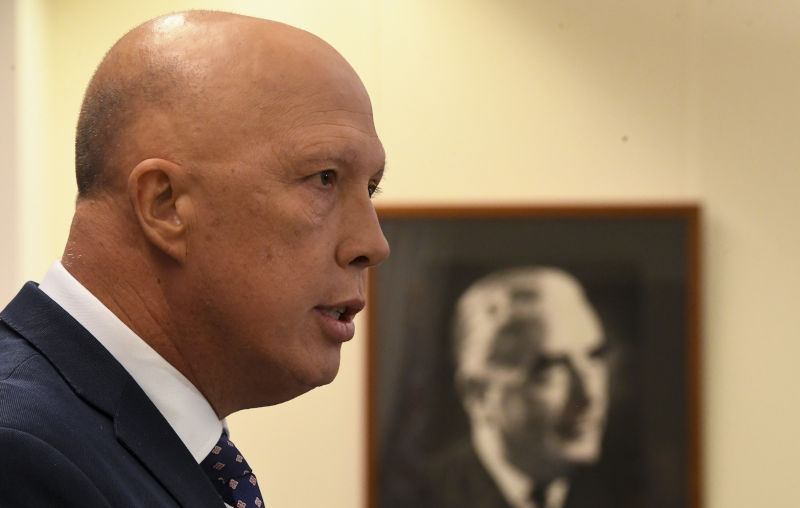Menzies, Dutton and the Liberal party
April 11, 2023
There is a huge difference between the problem Robert Menzies faced in creating the Liberal Party from the ruins of the United Australia Party during the second World War, and that facing Peter Dutton as he tries to unify the Liberal Party after its succession of defeats at federal and state levels in the past year or so.
Menzies had the easier task, by far. It took him just one election to make the Liberal Party a real force, and two to get it elected. The odds on Dutton beating or even equalling that timescale are dauntingly high.
In 1942 Menzies, who had served as Prime Minister from 1939 to 1941, was a backbencher in his United Australia Party when it was effectively destroyed in the 1943 federal elections, winning just 21.9 per cent of the vote (the Country Party received 8.5 per cent) against the Labor Partys 50.2 percent. He regained leadership of the party in Opposition but conditioned this on amalgamating (he called it gathering up) all the various organisations that constituted the United Australia into one single party the Liberal Party.
He called a conference in Canberra attended by representatives of 14 of those parties and persuaded them they needed to unite in a single Liberal Party with one federal organisation that had agreed objectives. It was to be a party espousing individual initiative and enterprise, in contrast with the socialism of the Labor Party.
Menzies had little difficulty in gathering the various anti-Labor forces together the electoral disaster of 1943 gave them little if any choice. In the following election in 1946 the new Liberal Party won 33 per cent of the vote, essentially picking up almost all of the 12 per cent of the voters who had opted for independents in 1943. The increased vote was just enough to allow Menzies to retain his leadership of the party.
In 1949, Menzies achieved a further 6 per cent swing to the Liberals and won government in coalition with the Country Party with a solid majority. Menzies attributed his victory to his campaign against the Labor socialists the Chifley Labor Government had tried, unsuccessfully, to nationalise the banks but a likely contributing factor in Labors defeat was war weariness (as had been the case in Britain where at the first post-war election, Winston Churchill, the nations wartime Prime Minister and hero, suffered an unexpected defeat). In Australia the privations of war had been infinitely less than in Britain, but some rationing of food and petrol, among other things, was still in force when Australians voted in 1949.
While Menzies campaigned against socialism, he insisted that the Liberals should not be branded as a party of reactionaries. In his 1944 speech to the representatives of the 14 groups that were brought together to form the Liberal Party he said, There is no room in Australia for a party of reaction. There is no useful place for a policy of negation.
Peter Dutton has adopted a strategy that rejects that wisdom as did Tony Abbott. But Abbotts success was due less to his own negative strategy than to the self-destructive leadership battles of Kevin Rudd and Julia Gillard. There is nothing to suggest the present Labor Government is likely to forget those events and repeat them.
Dutton sees his role not as gathering together and in some cases re-uniting the various groups that might constitute a successful Liberal Party so much as battling to unite those who are still members of it. Following his partys extraordinary loss of the Victorian seat of Aston he said, I have one test of my leadership, whether we can keep the party together.
But he seems prepared to do that by keeping just the rump of the party together and dispensing with those who do not accept his leadership that is, his policies and his strategy. Unity will come, it seems, by reducing the size of his party, and by marginalising and in some cases humiliating those who cannot be directly controlled.
For example, he gives the impression that he has no regrets about the resignation from the Liberal Party of the former Minister for Indigenous Affairs, Ken Wyatt, the first Aboriginal man elected to the House of Representatives. That came after he pushed his Vote No policy through first his shadow Cabinet, then his shadow ministry and finally a meeting of his parliamentary party.
Significantly, he also demanded that shadow cabinet members, including Julian Leeser and Senator Simon Birmingham, must not advocate a Yes vote. Leeser is the shadow minister for Indigenous Australians while Birmingham is the Liberal leader in the Senate and the leading small l Liberal in the Dutton pack. Some Liberal backbenchers will be supporting the Yes case in the referendum while others say they will remain silent.
Duttons stance on the referendum will be welcome by the fringe parties on the far right, including One Nation, but it will do nothing to strengthen the Liberal Party. It can only further antagonise those of its supporters who intend to vote yes and might be inclined to align themselves with the Teals.
While Menzies created a new Liberal Party by building a coalition of forces, Duttons drive for unity can only result in a party which casts off members and reduces its appeal to the electorate.
The advocacy of a no vote will certainly appeal to those older voters who are uncomfortable with welcome to country performances and announcements that have become all pervasive in recent years. It is unlikely, however, that they were ever part of the majority that the public opinion polls suggest currently support a yes vote.
Back in 1943, Menzies changed his partys name to help consolidate the anti-Labor organisations. Dutton is keeping the name but seems to be aiming to change the party that Menzies created.

